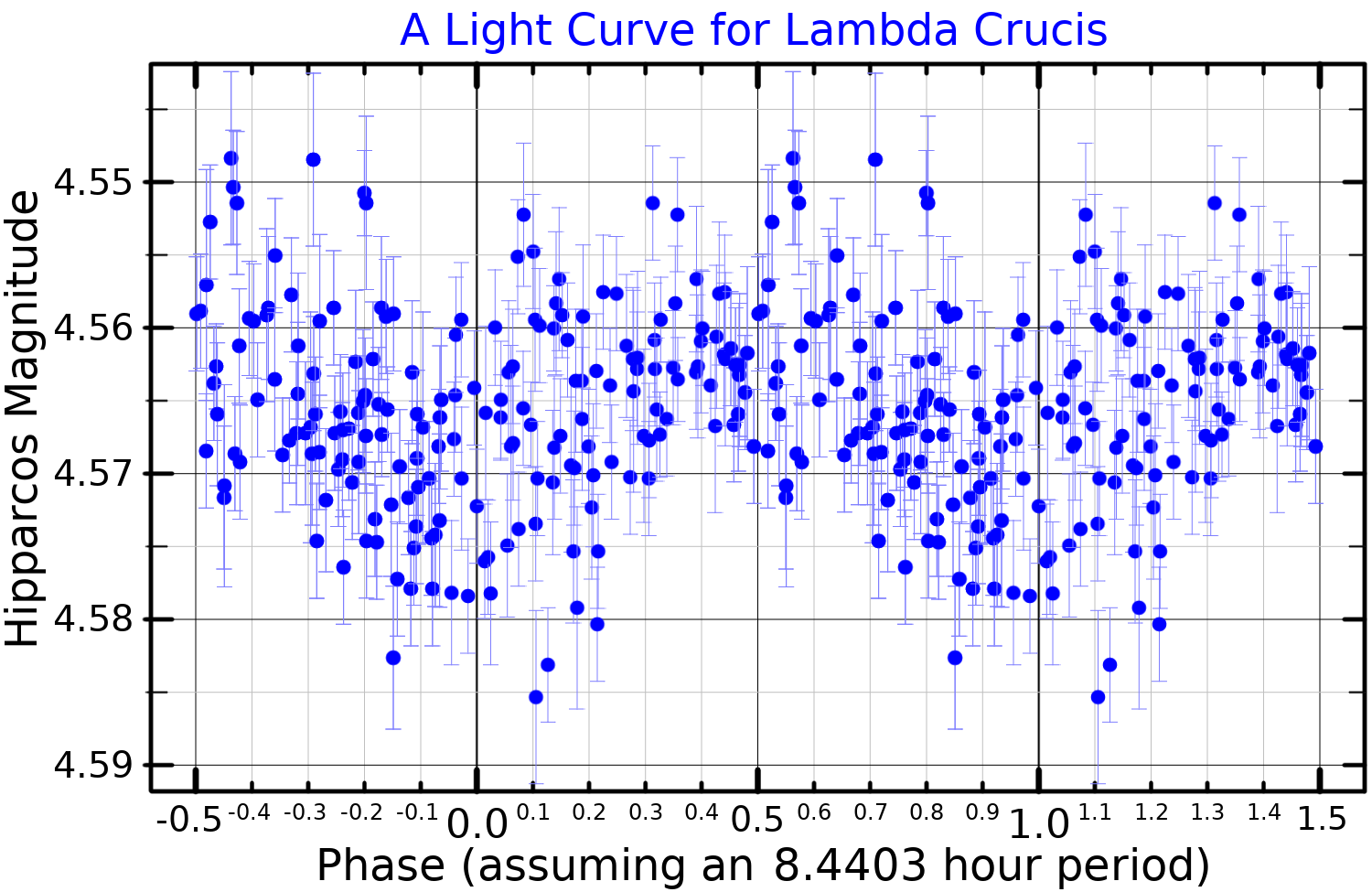Lambda Crucis on:
[Wikipedia]
[Google]
[Amazon]
λ Crucis, Latinized as Lambda Crucis, is a single,  λ Crucis is listed in the
λ Crucis is listed in the
variable star
A variable star is a star whose brightness as seen from Earth (its apparent magnitude) changes with time. This variation may be caused by a change in emitted light or by something partly blocking the light, so variable stars are classified as e ...
in the southern constellation Crux
Crux () is a constellation of the southern sky that is centred on four bright stars in a cross-shaped asterism commonly known as the Southern Cross. It lies on the southern end of the Milky Way's visible band. The name ''Crux'' is Latin for ...
, near the constellation border with Centaurus
Centaurus is a bright constellation in the southern sky. One of the largest constellations, Centaurus was included among the 48 constellations listed by the 2nd-century astronomer Ptolemy, and it remains one of the 88 modern constellations. ...
. It is visible to the naked eye as a faint, blue-white hued point of light with an apparent visual magnitude
Apparent magnitude () is a measure of the brightness of a star or other astronomical object observed from Earth. An object's apparent magnitude depends on its intrinsic luminosity, its distance from Earth, and any extinction of the object's lig ...
that fluctuates around 4.62. The star is located approximately 384 light-years distant from the Sun
The Sun is the star at the center of the Solar System. It is a nearly perfect ball of hot plasma, heated to incandescence by nuclear fusion reactions in its core. The Sun radiates this energy mainly as light, ultraviolet, and infrared radi ...
based on parallax, and is drifting further away with a radial velocity of +12 km/s. It is a proper motion member of the Lower Centaurus–Crux sub-group in the
Scorpius–Centaurus OB association,
the nearest such association of co-moving massive stars to the Sun.
 λ Crucis is listed in the
λ Crucis is listed in the General Catalogue of Variable Stars
The General Catalogue of Variable Stars (GCVS) is a list of variable stars. Its first edition, containing 10,820 stars, was published in 1948 by the Academy of Sciences of the USSR and edited by B. V. Kukarkin and P. P. Parenago. Second and thi ...
as a possible β Cephei-type variable
Variable may refer to:
* Variable (computer science), a symbolic name associated with a value and whose associated value may be changed
* Variable (mathematics), a symbol that represents a quantity in a mathematical expression, as used in many ...
. Its brightness varies with an amplitude of 0m.02 over a period of 0.3951 days. However, it is currently thought more likely to be a different type of variable, possibly a λ Eridani variable or rotating ellipsoidal variable
Rotating ellipsoidal variables are a class of variable star. They are close binary systems whose components are ellipsoidal. They are not eclipsing, but fluctuations in apparent magnitude occur due to changes in the amount of light emitting area ...
.
This object is a B-type main-sequence star
A B-type main-sequence star (B V) is a main-sequence (hydrogen-burning) star of spectral type B and luminosity class V. These stars have from 2 to 16 times the mass of the Sun and surface temperatures between 10,000 and 30,000 K. B-type star ...
with a stellar classification of B4 Vne, where the suffix notation indicates "nebulous" (broad) lines
Line most often refers to:
* Line (geometry), object with zero thickness and curvature that stretches to infinity
* Telephone line, a single-user circuit on a telephone communication system
Line, lines, The Line, or LINE may also refer to:
Arts ...
due to rapid rotation, along with emission lines
A spectral line is a dark or bright line in an otherwise uniform and continuous spectrum, resulting from emission or absorption of light in a narrow frequency range, compared with the nearby frequencies. Spectral lines are often used to iden ...
from circumstellar material, making it a Be star
Be stars are a heterogeneous set of stars with B spectral types and emission lines. A narrower definition, sometimes referred to as ''classical Be stars'', is a non-supergiant B star whose spectrum has, or had at some time, one or more Balmer e ...
. It is around 53 million years old and is spinning rapidly with a projected rotational velocity
Stellar rotation is the angular motion of a star about its axis. The rate of rotation can be measured from the spectrum of the star, or by timing the movements of active features on the surface.
The rotation of a star produces an equatorial bulg ...
of 341 km/s. The star has five times the mass of the Sun and about 3.0 times the Sun's radius. It is radiating 790 times the luminosity of the Sun
The solar luminosity (), is a unit of radiant flux ( power emitted in the form of photons) conventionally used by astronomers to measure the luminosity of stars, galaxies and other celestial objects in terms of the output of the Sun.
One nominal ...
from its photosphere at an effective temperature of .
References
{{DEFAULTSORT:Lambda Crucis B-type main-sequence stars Beta Cephei variables Lower Centaurus Crux Crux Crucis, Lambda Durchmusterung objects 112078 063007 4897 Be stars